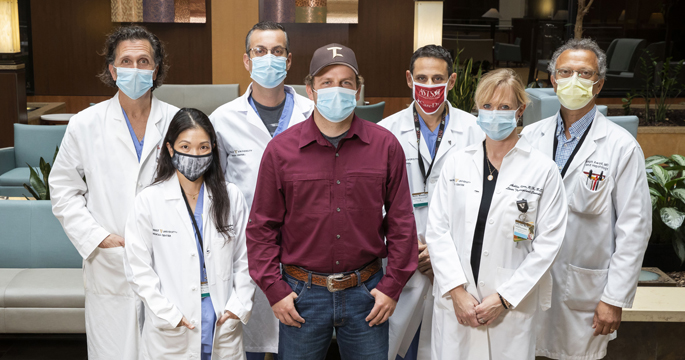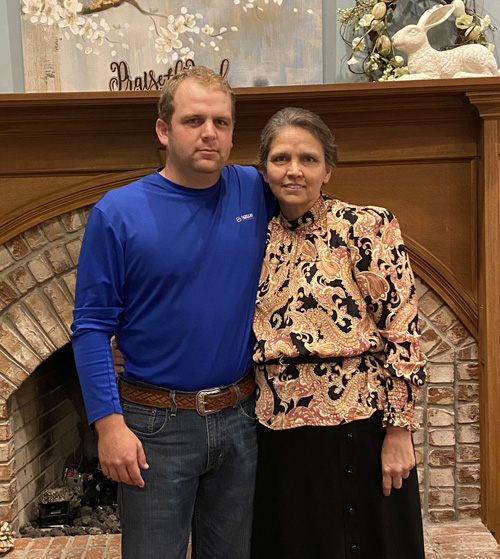
by Matt Batcheldor
Three years ago, Tammy Burnett learned her life was threatened by cirrhosis of the liver and needed a transplant. She got on the waiting list at multiple centers, but feared she might die because of the limited supply of matching livers from deceased donors, which could take years to arrive, if ever.
“I cried,” she said. “I was 50. And it’s just like I kind of went downhill from there.”
Last year, Burnett learned about the just-launched living liver donor program at the Vanderbilt Transplant Center, which allows relatives and friends to donate part of their liver to their loved one, something only possible at select centers in the country. The resulting partial livers in the donor and recipient have the ability to regenerate to become fully functional organs, typically within six weeks.
Her son, Sam, stepped up to donate part of his liver, and in March 2020, the two became part of the first living donor liver transplant at Vanderbilt since restarting the program last year, said Sophoclis Alexopoulos, MD, chief of Liver Transplantation. Vanderbilt previously performed living donor liver transplants in the early 2000s.
“We thought that this was a great opportunity because we felt that the risk of his mother waiting on the list was increasing and we were worried that she was going to die without a liver transplant,” said Alexopoulos, associate professor of Surgery. “This was a great opportunity for her son to do something for his mother and save her life.”

The Vanderbilt Transplant Center has since successfully performed two other living donor transplants, with excellent outcomes in donors and recipients, Alexopoulos said.
A living liver donation gives the recipient the opportunity to receive an organ sooner. People on the transplant list regularly wait months to years to receive an organ from a deceased donor. With a compatible living donor, a transplant patient may receive a live donor liver within weeks.
When Tammy learned that a living donation was possible, she asked all of her eight children, and any one of them would have done it, she said. In the end, Sam was the one chosen.
Sam knew how urgent it was. He remembers all the family gatherings the last several years where his mom was sitting in her recliner or in bed, feeling terrible, instead of bouncing around the kitchen as she usually did.
When he learned it was possible to save his mother’s life, it was never a question of whether he would donate part of himself, even if it meant a painful recovery for several weeks.
“If I had to do it over, I would do it all over again,” Sam said.
Tammy was a little taken aback when her son stepped forward to save her life. “Don’t make me cry,” she said, recalling the moment. “It was neat.”
Potential donors are screened in a multistep process, including a questionnaire, a visit with a donor advocate and a medical evaluation.
To donate a liver, the person must be a relative of a recipient, at least 18 and healthy enough to donate the liver.
Criteria include blood compatibility and no addiction to drugs or alcohol, major psychiatric illness or chronic medical conditions. A living liver donor can expect a normal, healthy life, Alexopoulos said.
The Burnetts’ transplant was an all-day procedure, starting with Tammy’s surgery. Once that was well underway, Sam’s procedure began, Alexopoulos said. The procedure involved two transplant teams, more than 20 people all together, including experts from Anesthesia, Surgery, Perfusion and Nursing.
“It took a lot of people to coordinate and make this happen, and that’s what live donor liver transplant is about,” Alexopoulos said. “It’s about having a strong team that works well together to have a successful outcome. I think that’s one of the things that Vanderbilt brings. We bring the depth of skill and dedication and caring to be able to offer this type of procedure safely and successfully.”
Both mother and son have recovered very well.
“I’m doing great,” Tammy said. “Way better than I’ve felt in years.”
Sam acknowledges that he dealt with pain for a few weeks after the procedure, but now is up to about 95% of his former strength and feels great. He complimented his medical team at Vanderbilt.
“I couldn’t have been more impressed, from the evaluation all the way through, even after I came home,” he said. “Dr. Alexopoulos called me personally and talked to me. A couple of days, there he was calling, checking up. And I was just absolutely amazed at the care. It was incredible.”
Alexopoulos said he hopes to spread the word that living donation is now a very real possibility that families in the Burnetts’ situation should consider.
“This is a real option,” he said. “We’re continuing to encourage people to consider it and come forward with it so that we can try and save people’s lives, so that we don’t have people dying waiting for a liver. If there is a way to prevent somebody from dying waiting for a liver, I think that’s really what we’re trying to accomplish.”












